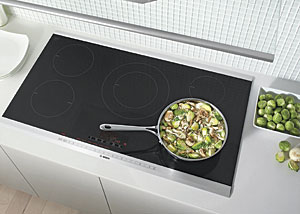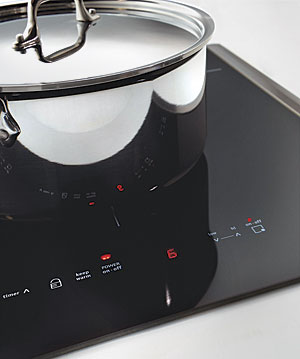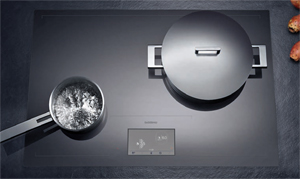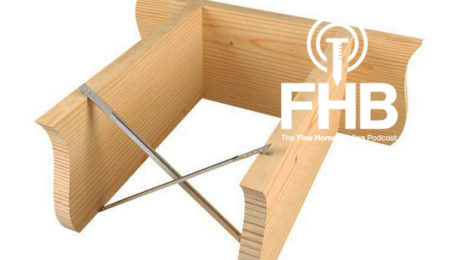Induction Cooktops: Magnetism Gets Things Cooking
The coolest feature of an induction cooktop is that elements don’t generate heat. In fact, these cooktops won’t work unless an appropriate piece of cookware is on the glass surface (more on that in a moment). An alternating current of electricity energizes a coil of copper wire beneath each heating area on the cooktop, creating a magnetic field. When a pot or pan with iron content or magnetic stainless steel is placed above the coil, the magnet excites electrons in the pan, causing them to vibrate. The friction of this agitation heats the pan and its contents. Because the friction is in the pan, the cooktop doesn’t heat up. Marketing campaigns for induction cooking show pans that have been cut in half, revealing things like ice melting in the pan but not on the exposed portion of the element. Although you can touch the cooking surface right next to a boiling pot, it’s important to recognize that the glass beneath cookware warms from its contact with the hot pot in the same way that coffee warms a mug; therefore, touching it can still burn you.
Induction cooktops have even better heat response than gas, and control can be precise. There isn’t any fiddling with a knob to adjust flame height. Push-button controls select the temperature, with up to 17 settings per element on the most flexible models.
Induction elements require cookware with ferrous content, so you may have to budget for new pots and pans in your kitchen renovation. Cookware manufacturers have begun adding an induction-compatible symbol to appropriate cookware. You can check your existing cookware or unlabeled new pots with a magnet. (It should stick.) To maximize efficiency, cookware bottoms should be flat. Cookware with an aluminum core is said to be best for taking advantage of induction’s strengths.
Some people are put off by noises that can accompany the heating process. These can include a slight humming sound on high-heat settings or the sound of a fan in the cooktop cooling the electronics, but noises aren’t that different from those made by a gas burner.
From Zero to Boil in Half the Time

This 36-in. Bosch 800-series cooktop (NIT8665UC; $2700) is laden with features that make cooking easier, including built-in timers for each element, overflow detection that sounds an alarm and shuts off the cooktop, and AutoChef for frying foods. Using a special pan, this last feature monitors and regulates the temperature inside the pan according to a specific food type.
Bosch’s 500-series midlevel induction cooktops ($1800 for the 30-in. version and $2450 for the 36-in. version) feature almost all the same specifications as the more expensive 800 series, save for the AutoChef function. Unlike gas burners, induction elements are not continuously variable; you choose a set heating level. Like the Gaggenau, the Bosch cooktops have 17 heat levels for greater control.
The highest heating level on most induction cooktops is typically labeled with “boost” appended to an active verb. Called SpeedBoost by Bosch, the setting brings a pot to boil very quickly; Bosch claims to halve the time it would take with a radiant electric burner. These settings work by redirecting some of the power from the other element on the same side of the cooktop. Although it limits the high power setting on the other element, the fast boil time seems like a worthwhile trade-off.
Magnets Heat Only Where the Pan Is

Magnets heat only where the pan is At $1300, Frigidaire’s 30-in. cooktop (FPIC-3095MS; left) is one of the more affordable induction cooktops on the market. It has all the basics: 15 cooking settings per burner, a timer, cooktop lockout to prevent small hands from turning on the stove, and digital touch controls. Its largest element is 10 in. dia. and 3400w. Although you shouldn’t use a pan that extends more than 1/2-in. beyond the cooking zone, this cooktop, like all induction cooktops, automatically adjusts element size to the pan if it’s smaller than the element.
World’s Most Flexible Cooktop?

Of Gaggenau’s four full-size induction cooktops, the full-surface induction unit (CX 491) has features that are out of this world, a phrase that might also apply to its $6050 price. Rather than consisting of several individual heating circles, the entire surface of the Gaggenau is capable of induction cooking. The cooking surface recognizes size, shape, and location of up to four pans, and it heats the areas under them. If you remove a pan, the element shuts off; return the pan to approximately the same position in less than 90 seconds, and the element returns to the previous setting. If you move the pan to a different place on the cooktop, you can transfer the timer information to the new hot spot with the touch of a finger. The cooktop cockpit is a small touch-screen display that you navigate like an iPhone. You set the temperature by swiping a finger to scroll through the 17 heat settings.

























